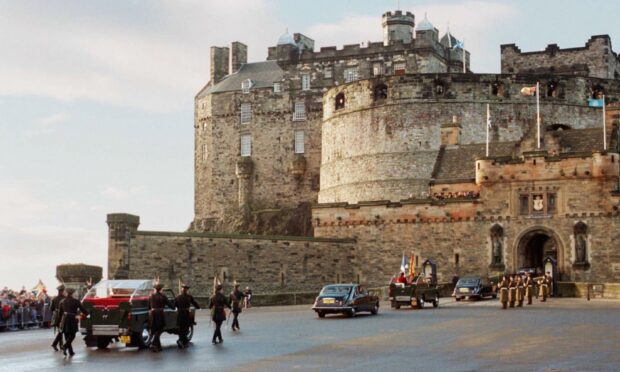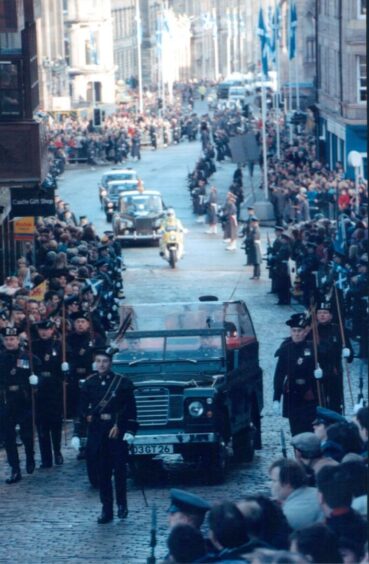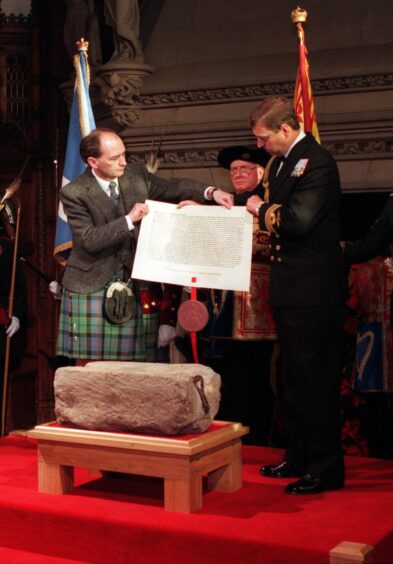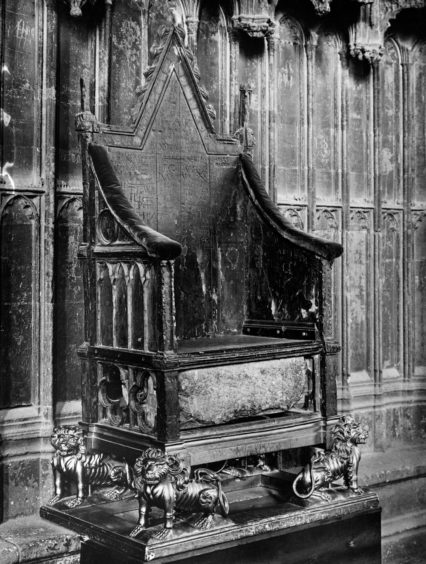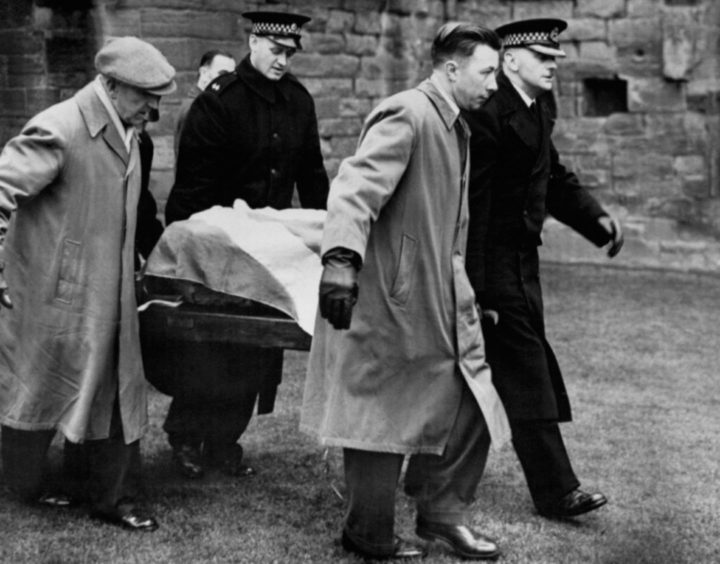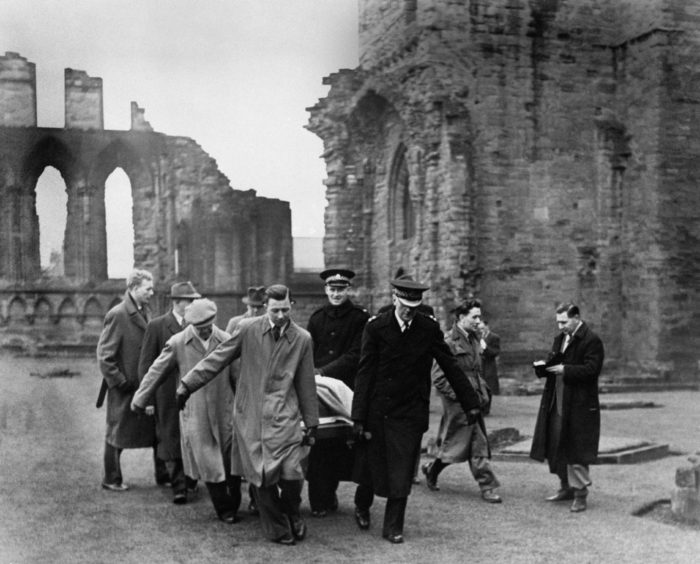Saltires fluttered from a forest of flagpoles before a 21-gun salute signalled the return of the Stone of Destiny to Scotland 700 years after it was first removed.
On St Andrews Day 25 years ago the Stone of Destiny completed a 400-mile journey under police escort from Westminster Abbey to Edinburgh Castle.
Scotland’s capital was functioning as the historic backdrop of a state occasion after Prime Minister John Major sprung a dramatic surprise in July 1996.
“The Stone of Destiny holds a special place in the hearts of Scots,” he said.
“On this the 700th anniversary of its removal from Scotland, it is appropriate to return it to its historic homeland.”
There were bids for Stirling Castle, Dunfermline Abbey, and Robbie the Pict wanted it to go on tour across Scotland.
The Stone ended up at Edinburgh Castle.
The Royal Mile may have been lined with onlookers, but there was little reaction to the passing event with only sporadic applause or cheers.
Just one military band, that of the Royal Marines, and a three-man mounted escort from the Royal Scots Dragoon Guards formed the first part of the procession.
The Duke of York and Scotland’s high and mighty followed in a convoy of eight vehicles.
The Stone was mounted on the back of a Land Rover and taken to St Giles Cathedral for a service of dedication before going on to Edinburgh Castle.
On the second leg, there was a flypast by four RAF Tornado fighters.
Later a 21-gun salute signalled the formal hand-over in the castle’s Great Hall.
The salute was returned by HMS Newcastle at Leith, several miles out at sea.
Sacred relic
Moderator of the General Assembly of the Church of Scotland, the Rt Rev John McIndoe, said the stone’s return was “a substantial landmark”.
And so it was.
This, after all, was a sacred relic.
It was the first time the stone had been publicly visible in Scotland for centuries.
Among those invited were the four people who, as young nationalists in 1950, prompted a nationwide alert when they took the Stone from Westminster Abbey.
The audacious raid was just another twist in the Stone of Destiny’s life as a holy relic which was fought over by the Scottish and English for more than 700 years.
The 400lb sandstone slab, reputed to be the stone on which the Biblical Jacob rested his head, is said to be the ancient coronation seat of Scottish and Irish kings.
It was taken from the Perthshire village of Scone in 1296 by King Edward I, the “Hammer of the Scots”, and brought to London.
Edward III promised to return it under the 1328 Treaty of Northampton but rioting mobs prevented its removal.
Built into a specially constructed throne, it remained at Westminster, until the daring raid on Christmas Day 1950 which has become the stuff of legend.
The ‘gang’ was made up of Glasgow University students Ian Hamilton, Kay Matheson, Gavin Vernon and Alan Stuart.
The original plan was to remove it two days earlier.
Hamilton was supposed to lock himself inside the church with tools hidden in his clothing.
He was going to unscrew the locks on one of the doors and let the rest of his group inside but he was disturbed by the Westminster Abbey watchman.
The students returned on Christmas Day when the church was in darkness and took a crowbar to the a side door and jemmied the lock.
The group managed to break the stone into two pieces when it crashed to the floor after being removed from under King Edward’s Chair.
The three men, using Hamilton’s coat, dragged the larger piece down the high altar steps, then Hamilton took the smaller fragment to the car waiting outside.
Hamilton placed the small piece in the boot of the Ford Anglia.
When a passing police officer looked vaguely suspicious of Hamilton and Matheson loitering at a getaway car, they started kissing and the pair posed as a courting couple.
The police officer, no doubt filled with the spirit of Christmas, chatted to the young “lovers” for a few minutes while taking the chance to have a fly smoke.
When they finally succeeded in smuggling the stone back to Scotland, it had to be repaired by Glasgow stonemason Robert Gray, who is long rumoured to have made copies of it.
The theft began a nationwide cat-and-mouse hunt, with the quartet successfully evading the authorities for several months.
Arthur Binnie
Many people in Scotland felt a thrill of pride at the audacity of the night raiders, but the establishment tended to deplore the way the relic had been retrieved.
The stone was stored in a variety of locations due to the intensifying police search, before the group eventually left it on the altar in the symbolic location of Arbroath Abbey, draped in a Saltire.
Arthur Binnie from the Arbroath Herald was at his desk on April 11 1951 when the phone rang with a tip that if he went to the abbey he may find something of interest.
He took the office camera and cycled there, to be met by the uniformed custodian who led him silently through the abbey ruins to the high altar.
There, he found the Stone of Destiny.
He was handed an envelope with a message from the four students.
Amazingly, he had the story all to himself.
Mr Binnie’s story and photographs went all over the world.
Shortly after 3pm, police arrived and four officers carried the Stone of Destiny to a waiting police van and taken to Forfar.
The stone was safely lodged in the prison part of the police station.
At 1am the stone was taken from the Forfar police cell and carried by road to Glasgow before being returned to Westminster Abbey.
The Home Secretary stated it wasn’t in the public interest to prosecute the students.
Ever since, there were persistent rumours that the stone returned to Westminster was a cunningly-made fake and that the real stone was still concealed in Scotland.
There have been several films and programmes about the theft, most famously the 2008 Canadian-Scots feature, Stone of Destiny, starring Charlie Cox and Robert Carlyle.But now the stone is about to be moved again to Perth following a decision announced last year by First Minister Nicola Sturgeon.
